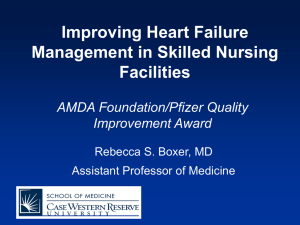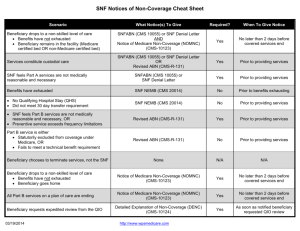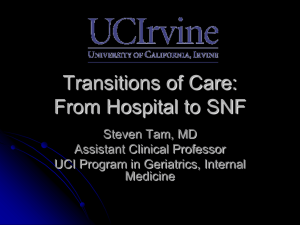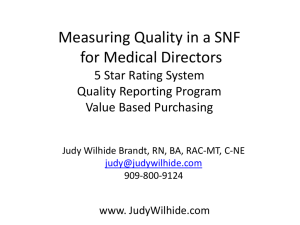The Final Rule, Value Based Purchasing, and Other Hot Topics
advertisement
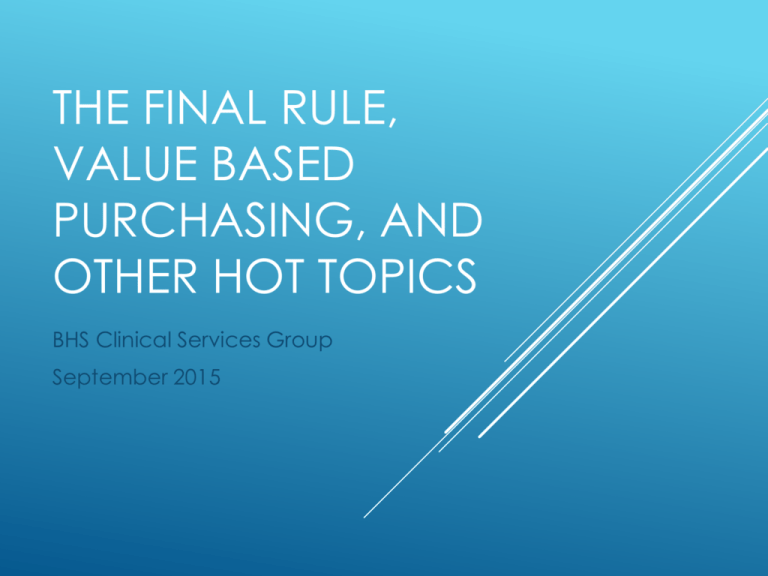
THE FINAL RULE, VALUE BASED PURCHASING, AND OTHER HOT TOPICS BHS Clinical Services Group September 2015 Familiarize and/or re-familiarize your understanding of the multitude of regulatory and payment changes occurring across the healthcare continuum Identify the steps each community can implement to be best prepared for the transformation Attain the top 10th percentile of quality utilizing Competency Based Training OBJECTIVES In the past 6 months you’ve learned: Cuts to Medicare Payment rates by 2% is coming (PAMA & VBP) Hips & knees bundles will be controlled by the hospitals (CMS Bundles) MDS Focused Surveys started for validating MDS accuracy Dementia Care Focused surveys have started CMS is adding new 5 Star quality measures in 2016 (IMPACT) Changes to the MDS effective October 1, 2016 (IMPACT) Payroll data must be submitted to CMS (PBJ) Changes ICD-9 coding to ICD 10 (ICD-10) Revised SNF requirements of participation regulations (ROP) Hospitals are asking if you are using Interact to reduce rehospitalizations HHS PAYMENT REFORM HHS announced targets to increase the number of payments that are linked to quality outcomes by 2018 “We are setting clear goals – and establishing a clear timeline --for moving from volume to value in Medicare payments” “Our first goal is for 30% of all Medicare provider payments to be in alternative payment models that are tied to how well providers care for their patients, instead of how much care they provide – and to do it by 2016. Our goal would then be to get to 50% by 2018” “Our second goal is for virtually all Medicare fee-for-service payments to be tied to quality and value; at least 85% in 2016 and 90% in 2018” HHS Secretary Burwell Jan 26, 2015 - David Gifford, MD, MPH, American Health Care Association Comprehensive person-centered care planning §483.21 Require proposed baseline care plan be completed within 48 hours of a resident’s admission. Increased coordination and updating to PASARR Mandatory members of IDT – add NA with responsibility for the resident, appropriate member of the food and nutrition services staff, social worker. THE PROPOSED FINAL RULE Facility Assessment – Annually Determine resources needed to “care for its residents competently both day to day operations and emergencies” Resident capacity and number of residents / Care required by the resident population Staff education and competencies required Determining staffing requirements Emergency Preparedness planning Physical environment needs for the population Ethnic, cultural, religious factors (r/t food and activities) Services provided (e.g. rehab, respiratory care) HIM needs QAPI development THE PROPOSED FINAL RULE Physician Credentialing MD/NP/PA present prior to sending a resident to the ED or hospital unless emergent Lab results must go to the exact person who ordered it Social Worker FT basis; Asking if other gerontology degrees would work in place of a SW Activity Director qualifications Sufficient Staff with competencies Respiratory Therapist THE PROPOSED FINAL RULE Behavioral Health Competencies: Propose to require that staff must have the appropriate competencies and skills to provide behavioral health care and services, which include caring for residents with mental and psychosocial illnesses and implementing non-pharmacological interventions. “Trauma Informed” staff Extending decreasing ALL psychotropic drug use (even include opioids, “and any other drug that result in effects similar to the drugs listed above (anti-psychotic, anti-depressant, anti-anxiety, hypnotic…) THE PROPOSED FINAL RULE Infection Prevention and Control Program (PICP) Infection Prevention and Controls Officer(s) (IPCO). Specialized training (undefined) Major responsibility of the individual assigned Ethics QAPI within 1 year after the date on which the regulations are promulgated And much more…! THE PROPOSED FINAL RULE (COMMENTS DUE WITH EXTENDED DEADLINE TO OCTOBER 14, 2015 Protecting Access to Medicare Act Improving Medicare Post-Acute Care Transformation IMPACT Value Based Purchasing PAMA VBP Payroll Based Journal PBJ PAYMENT AND QUALITY Top 10% in Quality of Care and Life Measures Excellent patient experience + Excellent Care = The Right Reimbursement Link to Proposed Final Rule: http://www.gpo.gov/fdsys/pkg/FR-2015-07-16/pdf/2015-17207.pdf Protecting access to Medicare act (PAMA) of 2014 links SNF rehospitalization to SNF Medicare Part A payments Uses a with-hold approach 2% “mathematical” withhold of SNF Part A payments 50-70% of the withhold is used to create an incentive pool SNFs can earn back their 2% withhold based on their rehospitalization performance score; Rehospitalization score is a combination of level of achievement and improvement, which ever is better First adjustment to a SNF’s payment will be in Oct 2018 based on performance likely starting in early to mid 2016 David Gifford, MD, MPH, American Health Care Association “IMPACT ACT OF 2014” Legislation has five parts : 1. Incorporate standardized clinical assessments 2. Public reporting of common quality measures 3. Provide quality measures to consumers when transitioning to a PAC provider 4. Interoperability of information at transfer 5. HHS and MedPAC to conduct several studies PAC REFORM Incorporate standardized assessment(s) (e.g. CARE tool) into existing assessment tools across all PAC providers (LTCH, IRF, SNF, & HH) for Pressure ulcers Functional status Cognitive status Others as directed by Secretary Collect standard data at admission and discharge Fully Implement by Oct 2018 “IMPACT ACT OF 2014” - PART 1 Publicly report quality measures across PAC settings Rehospitalizations Discharge to community Pressure ulcers Medication reconciliation Incidence of major falls Functional Status Patient preferences Efficiency measure(s): Avg Total Medicare Spend per Beneficiary Plus any other measures Secretary wants Measures to be approved by National Quality Forum (NQF) “IMPACT ACT OF 2014” PART 2 Red Txt specified by CMS in 2016 Proposed rules for SNF, IRF & LTCH ESTIMATED TIMELINE FOR SNF VBP IMPLEMENTATION Withhold Starts SNF comments Post withhold in Proposed Rule Analyze Data Collect Data Measurement Period Oct 2015 July 2016 Oct 2016 Oct 2017 Oct 2018 Oct 2019 SNF NATIONAL REHOSPITALIZATION RATES Likely to receive 2% back At risk for full 2% penalty All Policies involve re-hospitalizations: HRRP program financially penalizes hospitals with high 30 day readmission rates ACOs & bundle payment models can only financially work by lowering re-hospitalizations over 90 days SNF VBP Statute requires CMS to implements a 2% withhold of SNF Part A payments that can be returned based on your rehospitalization rates IMPACT act of 2014 requires CMS to measure and publicly report collection of PAC quality measures including re-hospitalization and Discharge to community Re-hospitalization rates will be added to Five Star Protecting Access to Medicare Act (PAMA) of 2014 – contains VBP section with re-hospitalization metrics. David Gifford, MD, MPH, American Health Care Association Adverse Events, OIG 2014 – findings show AE’s increase re-hospitalizations WHERE DO WE FOCUS? Adverse Events Medication Related 37% Care Related 37% Infection Related 27% Contributing to Re-hospitalization and lengthened length of stay OIG Adverse Events in SNF Report; February 2014 WHERE DO WE FOCUS? Re-hospitalizations Discharge to the Community Length of Stay 5 Star Rating 5 Star: QM’s 5 STAR Staffing Survey Preparedness Capacity & Competency Based Training (K-S-A) WHERE DO WE FOCUS? QM’s with Highest Impact on VBP: Pain Pressure Ulcer Satisfaction Falls with Major Injury Re-hospitalization Discharge to Community WHERE DO WE FOCUS? Specifies three measures New or worsening pressure ulcers Falls with injury Based on MDS SNF long stay falls measure Functional assessment at admission and discharge with goals Based on MDS SNF short stay pressure ulcer measure Based on Section IV of CARE tool (self-care & Mobility) Specify changes to MDS Adds section GG for self-care & mobility items from CARE tool Changes to Discharge Assessment Adds falls and section GG CARE items Requires discharge assessment at discharge from SNF Part A coverage FY 2016 PROPOSED RULE 5 STAR OVERALL SCORING METHODOLOGY Step 1: Initial star rating based on State ranking on your Survey Score Step 2: Add or subtract one Star based on Staffing component Subtract 1 star if staffing rating is 1 star Add 1 star if staffing is 4 or 5 stars & > Survey rating Step 3: Add or subtract 1 Star based on QM component Subtract 1 star if QM rating is 1 star Add 1 star if QM rating is 5 stars WHERE DO WE FOCUS? Value Based Purchasing 5 Star management – no return of the 2% if a community is not at least a 3 Star Community What can I control: Can plan on Staffing point with focus Can plan of QM’s with focus What can be managed but not controlled: Survey management not totally predictable Must have low scope and severity deficiencies Must pass the 1st re-survey WHERE DO WE FOCUS? Nurse Transition Coordinator Alignment with referral sources On-going progress towards goal discussions “Real” discharge planning Warm hand offs Appointment set up Patient goal setting Transportation Advanced Care Planning Socio-economical factors Patient / care giver education Follow-up calls Medication Reconciliation at each transition “Bed-side Care Conferences Patient satisfaction interview process KEY COMPONENTS OF A SUCCESSFUL TRANSITION Cost of Care Alignment with referral sources By co-morbids? Length of Stay (LOS) Interoperability St Catherine University possible grant Admission Criteria (Capacity) Alignment of brands (e.g. type of dressings) NURSE TRANSITIONS COORDINATOR Importance of Partnering Transparency Shared Risk Removing Barriers KEY COMPONENTS FOR SUCCESSFUL TRANSITIONS 5 Questions to Ask the Elderly based on Atul Gwande’s Book: “Being Mortal” 1. What is your understanding of where you are and of your illness? 2. What are your fears and worries for the future? 3. What are your goals and priorities? 4. What outcomes are unacceptable to you? What are you willing to sacrifice and not? 5. What would a good day look like? From Atul Gwande’s book: “Being Mortal” David Gifford, MN, MPH, AHCA/NCAL’s summary of “Being Mortal” ADVANCE CARE PLANNING TO REDUCE RE-HOSPITALIZATIONS Target individuals at high risk: How can you determine who is at high risk for readmission? Prior hospitalization in past 12 months is strong predictor ICU stay Long Hospital LOS (such as >10 days) How many risk factors that are used in OnPoint-30 Measure does the resident have Quick and simple approach is to add up the number of 33 risk adjusted variables a person has at admission to SNF Use systems to prevent adverse events that lead to hospitalizations Medication errors for medications that require monitoring Falls (often related to orthostatic hypotension) Infections David Gifford, MD, MPH, American Health Care Association TARGET INDIVIDUALS AT HIGH RISK Demographic Diagnoses Age >65 Anemia Male Asthma Medicare as Primary Payor Diabetes Mellitus Hx of Viral Hepatitis Hx of Septicemia Hx of Heart Failure Hx of Internal bleeding Functional Status Total Bowel Incontinence Eating dependent Needs 2 person assistance in ADLs Cognitive Impairment (Dementia) Prognosis Services & treatments End Stage prognosis poor Dialysis Recently rehospitalized Insulin prescribed Hx of Respiratory Failure Ostomy care Receiving Hospice Care Cancer Chemotherapy Receiving Radiation Therapy Continue to receive IV Medication Continue to receive oxygen Continued tracheostomy care Clinical Conditions Daily pain Pressure Ulcer Stage >2 (split into 4 variables) Venous Arterial Ulcer Diabetic Foot Ulcer RISK ADJUSTMENT VARIABLES USED Three strongest predictors from per JAMDA article: 1. Training provided to nursing staff on how to communicate effectively with physicians about a residents condition 2. Physicians who practice in this nursing home treat residents within the nursing home whenever possible, saving hospitalization as a last resort 3. Provided better information and support to nurses and aides surrounding end-of-life care FACTORS ASSOCIATED WITH LOW REHOSPITALIZATIONS 1Young Y et al. Clinical and Nonclinical Factors Associated with potentially preventable hospitalizations among nursing home residents in NYS. JAMDA 2011;12:364-371. Educate Knowledge Skill Train Attitude COMPETENCY BASED TRAINING: KSA Practice Clinical Needs of the Center Competency Based Training Critical thinking via Simulation CLINICAL CAPACITY Assess Referral Source Needs Create Admission Criteria Assess Gap Between Admission Criteria and Current Skill Level RAISING CAPACITY OF THE CARE CENTER • Reduce HF Hospitalizations Train • Red Flag Warning Signs • Practice Interventions Using Expected Scenarios Educate BUILDING CRITICAL THINKING Practice Use INTERACT PROGRAM Use all its components Its all about implementation FYI: MatrixCare is not updating Interact and will be using AMDA Clinical Practice Guidelines Root cause analysis of each hospitalization Start with the view point: 100% are preventable Risk stratify each admission for re-hospitalization risk Treat rehospitalizations as trigger to have end-of-life discussion David Gifford, MD, MPH, AHCA/NCAL DATA DRIVEN DECISIONS CMS SNF-RM POINTRIGHT PRO 30 MDS based Part A claims only All payer Part A SNF FFS 30 day window 30 day window During SNF stay only During & after SNF stay All cause readmission All cause readmission Observation included No observations Includes elective admits Excludes elective admits DATA: CMS SNF RM VS POINTRIGHT PRO 30 PointRight Pro 30 Rehospitalization* (now available) Discharge Back to the Community Length of Stay Improvement in Functional Status* (now available) (now available) Mobility (based on CARE tool) Self-Care (based on CARE tool) Customer Satisfaction*** Long Stay Hospitalization Unintended Healthcare Outcomes (now available)** (now available) (Oct 2015) (Mar 2016) DATA: AHCA DEVELOPED PAC MEASURES * NQF endorsed measures ** Requires use of CARE tool linked with MDS admission data *** Requires use of AHCA CoreQ satisfaction questionnaire Silver & Gold recipients have better Survey Scores and fewer deficiencies Quality Measures 5 Star Ratings Rehospitalization rates Staff Retention & less turnover Occupancy VALUE OF QUALITY AWARD Know your capacity and competency Re-evaluate your associate education/skill Focus on re-hospitalization rates Transitions of care Interact 4.0 Root Cause Analysis 5 Star Program: Focus on QM & Staffing in the 5 Star Program Survey Management – tools within the 360 MUST pass re-survey Focus on the upcoming new QM’s from IMPACT Cost of Care Don’t forget data integrity of MDS (Triple Check, MDS Audits, PointRight) Keep up with the professional reading & be networked ACTIONS APPENDIX What is the CCJR Proposal? Comprehensive Care for Joint Replacement (CCJR) Proposed Rule The proposal would Test 90 day bundled payments for lower extremity joint replacement (Hips & Knees) Apply to FFS Medicare Beneficiaries only Apply to hospitals in 75 Metropolitan Statistical Areas (MSAs) Run for five years Waives 3 day stay o Begin January 1, 2016 and end December 31, 2020 Payment & Pricing: Link to Quality Hospitals must meet minimum threshold on 3 quality metrics to receive their bonus: 1. Hospital Level Risk Standardized Complication Rate (RSCR) for elective Hip Arthroplasty (THA) or Total Knee Arthroplasty (TKA) 2. Hospital Level 30 Day, All Cause Risk Standardized Readmission Rate (RSRR) Following THA or TKA 3. Satisfaction based on Hospital Consumer Assessment of Healthcare Providers and Systems (HCAPHS) Survey Additional financial incentive to submit data on a patient- reported functional outcome measure Collect data on your performance & share with hospitals Rehospitalization rate during SNF stay & after SNF discharge Discharge to community rate LOS Improved function Satisfaction score Improve your rates on the measures that count Maintain 3 Star rating or higher TIPS ON HOW TO SUCCEED IN CCJR
